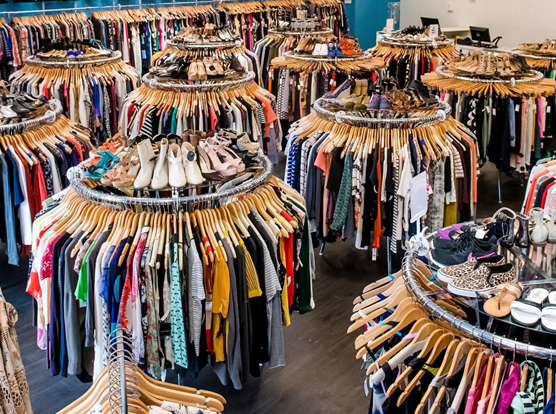The ascent of handed down Thrift shopping has carried expanded consideration regarding transfer stores and secondhand store. Both plans of action offer reasonable, manageable shopping choices, yet they work under on a very basic level various designs. For those new to the qualifications between the two, it tends to be confounding to separate transfer stores from secondhand store. This article gives a similar examination of transfer and frugality, investigating how these retail models contrast as far as obtaining, estimating, client experience, and business tasks.
What is a Consignment Store?
A transfer store works by selling things in the interest of their unique proprietors. People or organizations acquire their items — frequently clothing, adornments, furniture, or different products — to be sold in the store. At the point when a transfer store sells a thing, the first proprietor (the sender) and the store split the returns. The specific split changes yet frequently goes from 40% to 60% for the shipper and 40% to 60% for the store.
Consignment stores generally focus on higher-quality, well-maintained goods. Many specialize in certain types of merchandise, such as designer clothing, luxury handbags, or antique furniture. Consignors can sell directly their products or consign surplus inventory in the consignment stores.
What is a Thrift Shop?

Secondhand store, then again, work on a gift based model. Individuals give utilized products to the shop, and these things are then offered to clients at low costs. The income created from deals frequently upholds admirable missions, as numerous secondhand store are controlled by not-for-profit associations.
Secondhand store will generally have a more extensive and more different scope of stock, from dress and shoes to home merchandise, books, and gadgets. Since things are given as opposed to painstakingly organized, the state of merchandise in secondhand store can fluctuate generally. This implies clients could track down anything from fresh out of the box new things to vigorously worn items in a similar store.
Key Differences Between Consignment and Thrift

1. Sourcing and Inventory
· Consignment Stores:
Consignment stores source their goods from individuals who want to sell their items and make a profit. Each item is selected based on its quality, condition, and market demand. The inventory is usually more curated and includes higher-end or niche products. The consignor maintains ownership of the item until it is sold, and if it doesn’t sell within a certain period, they may take it back or allow the store to discount it.
· Thrift Shops:
Secondhand store depend on gifts from the general population, it is capricious to mean the stock. Anybody can give things, which prompts a wide assortment of product in changing circumstances. Since the things are given, the shop has no commitment to return them to the benefactor. Secondhand shops are frequently ready to sell things at exceptionally low costs since they secure merchandise at no expense.
2. Pricing Structure
· Consignment Stores:
Costs in transfer stores will generally be higher than in secondhand store, to a great extent on the grounds that the stock is arranged and frequently incorporates brand-name or planner merchandise. Transfer storekeepers commonly research market costs prior to setting the cost for every thing, guaranteeing it lines up with flow resale values. Shippers are likewise persuaded to value their things higher on the grounds that they get a level of the last deal cost. Nonetheless, things might be limited on the off chance that they don’t sell inside a particular time span.
· Thrift Shops:
Conversely, secondhand store costs are by and large much lower. Since the things are given, secondhand store can stand to sell them at lower costs. There is typically less accentuation on market esteem, and the objective is frequently to rapidly move stock. Also, numerous secondhand shops hold continuous deals or proposition limits on unambiguous things to clear space for new gifts.
3. Quality and Condition of Goods

· Consignment Stores:
Since transfer stores curate their stock, they will more often than not center around greater things. Clothing should be spotless, liberated from harm, and normally in-season. Architect marks, previously owned furnishings, and novel or significant merchandise are normal in transfer stores.
· Thrift Shops:
Secondhand shops acknowledge a more extensive scope of products, and the state of things can change broadly. While it’s feasible to find great or even new things in a secondhand store, customers are likewise prone to experience vigorously worn or obsolete items. This extensive variety of value is important for the interest for the vast majority deal seekers, who partake in the “expedition” part of tracking down unlikely treasures among the more normal things.
4. Customer Experience
· Consignment Stores:
In transfer stores, the shopping experience will in general be more organized. The stores are many times efficient, with things assembled by class, size, or fashioner. Clients can hope to track down a more elevated level of administration, with staff accessible to help with inquiries concerning valuing or item history.
· Thrift Shops:
Secondhand store will generally offer a more self-administration experience. While many are efficient, the sheer volume and assortment of merchandise can make the shopping experience less unsurprising. Customers might have to filter through racks of things to track down something that suits their taste or needs. The excitement of finding an extraordinary arrangement or novel thing is a huge draw for deal seekers, who frequently view their visits as an expedition.
5. Business Model and Ownership

· Consignment Stores:
Consignment stores are typically for-profit businesses. They operate by splitting the sale proceeds with the consignor, which provides an incentive for both parties. Consignment stores focus on curating a selection of items that are likely to sell, meaning they invest time in evaluating and pricing products to attract the right customers.
· Thrift Shops:
Numerous secondhand store are controlled by not-for-profit associations, and the returns from deals frequently go to admirable missions. The gave stock permits these shops to work with negligible above costs, and the essential objective is to raise assets for their main goal as opposed to expand benefits.
Conclusion
While transfer stores and secondhand store both assume a critical part in the handed down retail market, they take special care of various requirements and inclinations. Transfer stores center around better, organized things, offering a more shop like shopping experience with greater costs and designated stock. Secondhand store, conversely, offer a more extensive scope of products at lower costs, interesting to deal trackers and the people who partake in the excitement of tracking down surprising fortunes.

